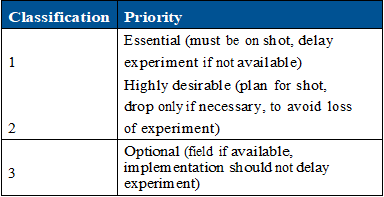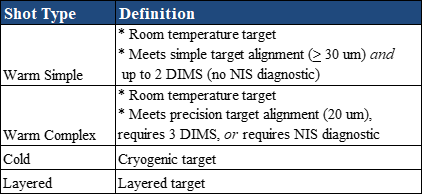The first step in the execution of a planned NIF experiment (following the awarding of time to successful proposals) is submission of the initial experiment definition at the Scheduling gate via the NIF User Portal. The definition consists of the essential data needed for scheduling of experiments. The different categories of attributes are described below:
- Experiment Name: The identifier for the experiment used for planning is defined here. The identifier is a concatenation of abbreviations for the program, campaign name, sub-campaign name, and the platform name. See Section 3.1.3 for a more detailed description of this identifier.
- Experiment Scheduling: Shot allocation quarter and a scheduled no-later-than date are entered here. Also, if the newly-defined experiment must be scheduled after any predecessor experiment, the predecessor is called out here.
- Diagnostic Request: Diagnostic instruments that are inserted into the target chamber via a DIM are listed here; for each DIM-diagnostic, priority and type should be indicated per Table 3-1. This is a first attempt at describing the DIM diagnostic configuration; following facility reviews and negotiation, the final set of participating DIM diagnostics will be determined at a later date. Of course, anything the PI or RI determines as primary to their physics goals will be treated as such.
Any new diagnostic instrument needed for the experiment is specified here as well. Any known required calibration or commissioning activities should also be listed, as this helps the facility to plan ahead and work with the RI to ensure that analyzable physics data is obtained.
Table 3-1. Diagnostic priorities and types.
- Laser Setup: The fundamental laser parameters that provide a rough sketch of the laser drive envelope are entered in this section of the definition. The parameters include laser energy, laser power, total number of beams, and backlighter beams. It is understood that detailed laser parameters will be clarified and finalized at a later time.
- Target and Target Handling Summary: If the target will be fabricated by LLNL, the complexity of the target is specified per Table 3-2. If a similar target has been fabricated before, that must be indicated along with the differences between the previous target and the new request. If the target will be fabricated at another institution, this fact should be stated here instead as an additional comment. Note that the target will still need to be metrologized at NIF and potentially undergo expert group reviews (see Section 3.3).
Table 3-2. Target complexity levels.
The essential requirements for target handing are also entered in this section of the definition. The target positioner, target gas fill, target temperature, and shot type are all listed. A more detailed description of target handling capabilities can be found in Section 5.4. A description of the various shot types is shown in Table 3-3, below.
Table 3-3. Shot type definitions.







